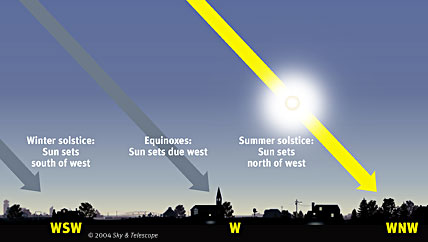
Friday, June 13
Vega is the brightest star shining in the east after dusk. It's currently the top star of the big Summer Triangle. The brightest star to Vega's lower left is Deneb. Look farther to Vega's lower right for Altair. The Summer Triangle will climb higher in early evening all through the summer, to pose highest overhead at dusk just as fall begins.
Saturday, June 14
Mars and Spica arrest your eye in the southwest just after dark this week. Spot brighter Arcturus high above them. Half as far below them is the four-star pattern of Corvus, the Crow.
Sunday, June 15
The waning gibbous Moon rises in the east-southeast around 11 p.m. (depending on where you live). Well to its upper left shines Altair, flagged by the little star Tarazed about a finger-width at arm's length above it. Left or lower left of Altair, by about a fist and a half at arm's length, look for the compact constellation Delphinus, the Dolphin.
Monday, June 16
After dark, look below Mars and Spica in the southwest for the four-star pattern of Corvus, the Crow. It's a springtime constellation descending now that spring is nearing its end.
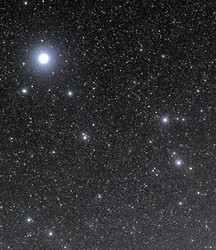
Tuesday, June 17
Vega is the brightest star high in the east. Barely to its lower left after dark is one of the best-known multiple stars in the sky: 4th-magnitude Epsilon (ε) Lyrae, the Double-Double. It forms one corner of a roughly equilateral triangle with Vega and Zeta (ζ) Lyrae. The triangle is less than 2° on a side, hardly the width of your thumb at arm's length. Binoculars easily resolve Epsilon (not quite resolved in the photo here), and a 4-inch telescope at 100× or more should resolve each of Epsilon's two wide components into a tight pair.
Zeta Lyrae, the triangle's third star, is also a double star for binoculars, much tougher, but it's easily split with a telescope. Delta Lyrae, the next star down, as a much wider binocular pair; it's resolved in the photo.
Wednesday, June 18
With Scorpius coming up into good evening view now, keep an eye on the doings of Delta Scorpii. This is the middle star in the row of three marking Scorpius's head. In July 2000 it unexpectedly doubled in brightness. It has remained brighter than normal ever since, with fluctuations, at about magnitude 2.0. Compare it to Beta Scorpii above it, magnitude 2.6, and Antares, 1.1. See the June Sky & Telescope, page 51.
Thursday, June 19
Now that the Moon is out of the evening sky, plan some new deep-sky hunts with your scope! You may know of the splendid globular star clusters M10 and M12 in Ophiuchus. But what about the lesser-known galaxies to their northwest? Track them down with Sue French's Deep-Sky Wonders article and chart in the June Sky & Telescope, page 56.
Friday, June 20
This is the time of year when the two brightest stars of summer, Arcturus and Vega, shine equally high overhead as evening grows late: Arcturus in the southwest, Vega toward the east. Arcturus and Vega are 37 and 25 light-years away, respectively. They represent the two commonest types of naked-eye stars: a yellow-orange K giant and a white A main-sequence star. They're 150 and 50 times more luminous than the Sun — and this, combined with their nearness, is why they dominate the evening sky.
Saturday, June 21
If you have a good dark sky, look east as the final glow of twilight fades away. All across the low eastern sky, the starry, mottled band of the Milky Way is looming up. It rises higher through the night and crosses straight overhead around 3 a.m.
The June solstice occurs at 6:51 a.m. Eastern Daylight Time, when the Sun reaches its northernmost point in the sky for the year and begins its six-month return south. Summer begins in the Northern Hemisphere, where today is the longest day. In the Southern Hemisphere, this is the start of winter and the longest night.
Want to become a better astronomer? Learn your way around the constellations. They're the key to locating everything fainter and deeper to hunt with binoculars or a telescope.
This is an outdoor nature hobby; for an easy-to-use constellation guide covering the whole evening sky, use the big monthly map in the center of each issue of Sky & Telescope, the essential guide to astronomy. Or download our free Getting Started in Astronomy booklet (which only has bimonthly maps).

Once you get a telescope, to put it to good use you'll need a detailed, large-scale sky atlas (set of charts). The standards are the little Pocket Sky Atlas, which shows stars to magnitude 7.6; the larger and deeper Sky Atlas 2000.0 (stars to magnitude 8.5); and once you know your way around, the even larger Uranometria 2000.0 (stars to magnitude 9.75). And read how to use sky charts with a telescope.
You'll also want a good deep-sky guidebook, such as Sue French's Deep-Sky Wonders collection (which includes its own charts), Sky Atlas 2000.0 Companion by Strong and Sinnott, the bigger Night Sky Observer's Guide by Kepple and Sanner, or the beloved if dated Burnham's Celestial Handbook.
Can a computerized telescope replace charts? Not for beginners, I don't think, and not on mounts and tripods that are less than top-quality mechanically (able to point with better than 0.2° repeatability, which means fairly heavy and expensive). As Terence Dickinson and Alan Dyer say in their Backyard Astronomer's Guide, "A full appreciation of the universe cannot come without developing the skills to find things in the sky and understanding how the sky works. This knowledge comes only by spending time under the stars with star maps in hand."
This Week's Planet Roundup
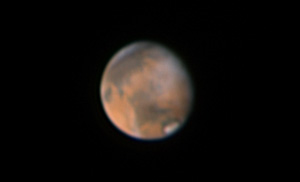
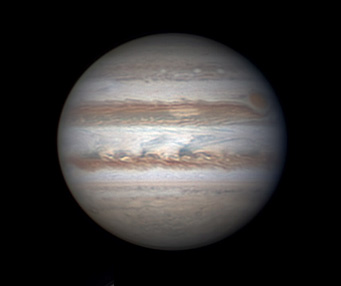
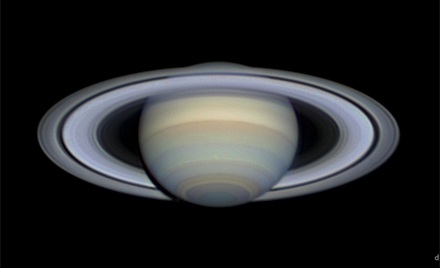
Mercury is lost in the glow of sunset.
Venus (magnitude –3.9) shines low in the east during dawn.
Mars (magnitude –0.2, in Virgo) is high in the south-southwest in twilight, with Spica to its left. Mars sets in the west around 1 or 2 a.m. daylight saving time.
In a telescope, Mars's gibbous disk is 10.5 arcseconds tall and shrinking. See the Mars map and observing guide in the March Sky & Telescope, page 50. Use our Mars Profiler to find which side of the planet will be facing Earth when you plan to look.
Jupiter (magnitude –1.8, in Gemini) shines low in the west-northwest in twilight and sets around nightfall. Look for Pollux and Castor, much fainter, to its upper right.
Saturn (magnitude +0.3, in Libra) glows in the southeast to south during evening. The wide binocular double star Alpha Librae glimmers 3° to Saturn's lower right; they easily fit within a typical binocular's field of view.
Well off to Saturn's right shine Spica and then Mars. Look for Antares and the head of Scorpius down to Saturn's lower left.
In a telescope Saturn's globe is 18 arcseconds wide, and its rings are tilted 22° from our line of sight. Use our SaturnMoons app to find and identify Saturn's various satellites at any time and date. A 6-inch scope will show four or five of them: Titan, Rhea, Dione, Tethys, and sometimes Iapetus.
Uranus, in Pisces, is low in the east just before dawn begins.
Neptune, in Aquarius, is up in the southeast before the first light of dawn. Use our finder charts for Uranus and Neptune in 2014.
----------------------------------
All descriptions that relate to your horizon — including the words up, down, right, and left — are written for the world's mid-northern latitudes. Descriptions that also depend on longitude (mainly Moon positions) are for North America.
Eastern Daylight Time (EDT) is Universal Time (UT, UTC, or GMT) minus 4 hours.
 18
18
Comments
mary beth
June 14, 2014 at 12:48 am
Speaking of triangles.....I noticed that Mars, Saturn and Arcturus made an almost perfect equilateral triangle this evening (similar in size to the winter triangle). Thank you for the Sunset chart! Happy Summer Stargazing to S&T readers!
You must be logged in to post a comment.
David Dunn
June 15, 2014 at 4:35 am
I hadn't notice that before. I believe this temporary triangle of Mars-Saturn- Arcturus is actually bigger bigger than the WInter Triangle, but not by too much. Speaking of which, this year we had the Winter diamond as Jupiter formed a 4-sided figure with Betelgeuse, Sirius and Procyon.
You must be logged in to post a comment.
mary beth
June 15, 2014 at 11:10 am
Ah, the wonder of the "wandering stars"! It's fun to see what shapes will be occur since the planets aren't constant! Maybe we should coin the term 'conplanetation' for our discoveries!!
How long did the diamond last? I think you're right about the size. It surprises me how small the winter triangle is. I believe you can see it with one glance....?
You must be logged in to post a comment.
David Dunn
June 16, 2014 at 11:39 am
"Conplanetation" (lol) very nice! The diamond lasted about 2 months or so, it was when Jupiter had finished its retrograde motion and was in the middle of Gemini. This was coined in Sky-At-a-Glance for example the February 22 entry from .
You must be logged in to post a comment.
David Dunn
June 16, 2014 at 11:41 am
From this Link.
You must be logged in to post a comment.
mary beth
June 16, 2014 at 1:53 pm
All the bright ones! Will it be back again in the next few years? Do you have any links to easy-to-understand articles on retrograde motion? Wikipedia has too much info! I'm looking for a short, simple explanation. I think I understand it but want to be sure! You mention Mars was in retrograde but is now moving Eastward, so is it out of retrograde or is its eastward movement part of the retrograde? Thanks for any info! You have me closely marking Mar's position each night from the same spot/same time.
You must be logged in to post a comment.
David Dunn
June 16, 2014 at 8:22 pm
Since Jupiter has a nearly 12-year period around the Sun, It should be back in the general area in 2026, though it probably won't be quite same part of the retrograde loop and stay in the same spot for several weeks.
As for Retrograde motion - it really is function of one planet overtaking another. When the Earth overtakes Mars, the planet appears to go backwards in the sky. This You Tube does a decent job, explaining the 2010 opposition of Mars.
Retrograde motion
Retrograde motion really is the apparent westward motion of the planet, when it finishes that and resumes its apparent eastward motion it's in prograde motion. I suppose the east - west - east motion that Mars (and other planets) might be called the retrograde loop, though the retrograde motion is really only the westward motion of the planet.
You must be logged in to post a comment.
David Dunn
June 16, 2014 at 8:25 pm
Here the You Tube Link:
Retrograde motion
You must be logged in to post a comment.
mary beth
June 17, 2014 at 1:55 am
Thank you so much for sharing your knowledge! Yes, the video explained it very well! I watched it several times and paused it so I could study the graphics. It was just what I was hoping for! (Now I'm curious about the time period around the sun for each planet.) I also got the added bonus of appreciating opposition since it was explained well. I would read about it but I didn't understand its importance until tonight! Thanks again for the time and effort you put into this - it will be more enjoyable and interesting to observe the planets since I know more about their orbits! I hope other readers see your link!
You must be logged in to post a comment.
David Dunn
June 17, 2014 at 5:19 pm
I'm glad I could help! Teaching this material every semester makes it a little easier to explain. How long have you been interested in Astronomy?
You must be logged in to post a comment.
mary beth
June 17, 2014 at 9:20 pm
I always liked the beauty and mystery of the night sky but it wasn't until I met a pilot friend who told stories of navigating by the stars, which intrigued me. (He had an WW2 sextant he played around with). Then in 2002 or so another friend, who sailed, told me about Sky& Telescope.com. Honestly, the Sky at a Glance was so simple and fun that I learned quite a few stars and constellations immediately. Then I just started finding other sites that were interesting, but S&T, along with their iPhone app which I LOVE, has always been my favorite. I regret not getting interested in stargazing earlier. I find it almost sad in this age of information that very few people can identify even the most common stars, and confuse stars and planets, etc.! In the last ten or twelve years now, I can't wait to get outside, watch the sunset, enjoy the three phases of twilight, and then watch as the planets and stars appear. It's all very magical, and it never is boring! I'm outside right now watching one of the last Spring sunsets, and seeing how early I can spot Jupiter!
Sorry such a long story!
How about you?
You must be logged in to post a comment.
David Dunn
June 17, 2014 at 11:18 pm
I got interested in astronomy as young kid. I remember the last Apollo Moon mission and watched Star Trek, but my interested piqued when my brother and father build a telescope in our backyard when I was young back in 1975. My dad subscribed to Sky and Telescope and I started to read about it. That same year I saw a lunar eclipse, Mars in opposition and then the next year I witnessed Comet West in the morning sky - I've been hooked ever since (enough to get an advanced degree!) and even after all those years I still like observing the night sky. And I agree, the sky never gets boring and Astronomy always has new news about just about everything, keeping it fresh.
You must be logged in to post a comment.
mary beth
June 18, 2014 at 12:14 am
You were a lucky kid :)! Do you still have some old issues? Sounds like your whole family was interested, that's fantastic! I'd love to hear about the telescope they built! I hope your brother stayed interested.
My best friend's parents took us to a Star Trek convention at a hotel when we were little girls in about 1971. I bought an original Tribble, which I still have lol! She was a big fan, but Spock scared me!
Living by Johnson Space Center, I have been able to meet several astronauts through friends. A good friend of mine worked for NASA flying them all over the country in the T-38. Her name is in the credits of the Apollo 13 movie. She also flew the KC-135. Hate its nickname!!
I'm going to read about Comet West. Just saw an image - no wonder you were hooked!! That's great you are doing what you love, and that you had encouragement from your parents! If you have kids I hope they are interested as well!
You must be logged in to post a comment.
David Dunn
June 18, 2014 at 2:21 am
I was a lucky kid! My brother and father are still interested in astronomy. My parents were always encouraging in my pursuing astronomy. I have no kids, but at least one nephew seems to like astronomy. And I get to show my enthusiasm about astronomy to my classes and our Astronomy Club.
No, I don't have the original issues my dad had, but I did manage to get a copy of the January 1975 issue (the first one I ever read) at a talk I gave many years ago and now at my school, I have access to many old issues that retired colleagues have kept. It is neat to look at the old issues and see how the style of the magazine has changed.
You are so lucky to meet several astronauts! I can't recall if I've met one or even seen one give a talk. I know several years before I got to my school, one of our colleagues got Jim Lovell (Apollo 13) to speak. What a job your friend has escorting those astronauts across the nation!
Yes, Comet West was quite spectacular - perhaps the best comet I've seen (even better than Hale-Bopp). I still have the drawings I made of it as a kid 🙂
You must be logged in to post a comment.
mary beth
June 18, 2014 at 11:33 am
Okay - I have GOT TO SEE your drawings!! That's awesome you saved them!! Markers, crayon, colored pin, Spirograph?? I hope you have them framed and preserved properly!
My friend is very good friends with Astronaut Scott Horowitz. He has a lovely wife and family. I got to meet them at their kids' birthday parties. Another friend was married to Gerald Carr's son, and I have seen a few others at the FBO.
I read that Comet West was not highly publicized in mainstream media - too bad!! It was listed as one of the 9 most brilliant comets of all time! I never heard of it until you told me. The images are BEAUTIFUL!! Im going to use one as my background onnmy ipad. I sure wish I would've seen it!! It truly shaped your future and led you on a fun and successful path! (Advice to self: follow that comet!!)
By the way.....there's a band called Comet West, lol!! They look real young but someone in their families must have known about the comet!!!
You must be logged in to post a comment.
David Dunn
June 18, 2014 at 8:12 pm
My Drawings were done by pencil. And I do show it in my class when we talk about comets (Not sure how I'd show it here). Comet West was deemphasized in part because of the fiasco of Comet Kohoutek which was hyped up and disappointed so many. I am itching to see another comet that spectacular - that really good one has Hale-Bopp in 1997 (Comet McNaught in 2007 and Comet LoveJoy in 2011 could not been seen from here).
You must be logged in to post a comment.
David Dunn
June 18, 2014 at 11:02 pm
I should clarify: the last one I saw was Hale-Bopp in 1997. Hopefully, you saw that one too?
You must be logged in to post a comment.
mary beth
June 19, 2014 at 1:29 am
I do remember seeing Hale-Bopp but I sure wish I had been more interested in astronomy at the time. I didn't see it through a telescope but I do remember it being such a strange and beautiful sight, almost like it was alive! If it were around now, I'd jump through hoops to see it continually. I have the Wikipedia page on comets pulled up to read tonight. From the few things I've read so far, it sounds like a comet could theoretically surprise us, in line with what you said earlier - the heavens are always giving us something new to be excited about!
We had some rain earlier today and it cleared the atmosphere so the planets were so brilliant tonight! Even before astronomical twilight I saw the little stars around Saturn. Everything was so pretty! Jupiter was very bright and low, and I was thankful I could see it so well that late (from my mom's house). The big dipper is sure rotating! Also, I could finally see Vega easily. It's finally made it over my neighbor's huge old oak tree right at dark lol! Perfect timing for Saturday's solstice!
"Behold, His ensigns sweep the sky,
New comets blaze and lightnings fly..."
Isaac Watts, Psalm 65 Part 2 Divine Providence in Air, Earth, and Sea.
Goodnight!
You must be logged in to post a comment.
You must be logged in to post a comment.